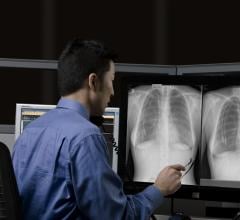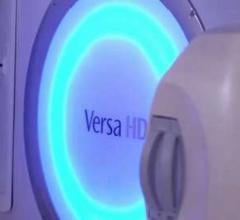August 20, 2014 — MRI Interventions Inc. announced that neurosurgeons at UC San Diego Health System have utilized the ClearPoint system's platform capabilities to facilitate three same-setting MRI (magnetic resonance imaging)-guided neurosurgical procedures for a single patient.
August 20, 2014 — Additive manufacturing (3-D printing) company Oxford Performance Materials (OPM) announced it has received 510(k) clearance from the U.S. Food and Drug Administration (FDA) for its 3-D printed OsteoFab patient-specific facial device.
NorthStar Medical Radioisotopes LLC signed a non-exclusive letter of intent with GE Healthcare, a division of General Electric Co., marking further progress toward establishing the first existing commercially viable domestic source of the radioisotope 99molybdenum (99Mo).
Radiology departments have many different needs and face a wide variety of challenges that can impact their departments ...
GE Healthcare introduces the Vscan with Dual Probe with the first of its kind 2-in-1 probe to give healthcare providers more uses for pocket ultrasound.
Carestream is receiving orders from healthcare providers around the world for its new Carestream Managed Print Solutions (MPS), a comprehensive, Web-based, pay-per-print program that tracks laser imaging film usage, and remotely monitors and delivers film inventory according to each facility’s needs.
August 20, 2014 — Advanced Ultrasound Electronics announced the availability of Sono-Wipes, a one-step disinfectant deodorizer wipe specifically made for ultrasound equipment.
Despite decades of progress in breast imaging, one challenge continues to test even the most skilled radiologists ...
August 20, 2014 — Three out of four people would want to know what kind of neurological disorder they had, even if there was no cure, according to new global research from GE Healthcare. The “Value of Knowing” global survey of 10,000 adults across 10 countries explored perspectives on incurable neurological disorders including Alzheimer’s (AD) and Parkinson’s (PD) disease.
August 20, 2014 — Vital Images Inc. received 510(k) clearance from the U.S. Food and Drug Administration (FDA) for its Image Denoising software, a post-processing filter designed to be used in conjunction with original image data used with its Vitrea software.
Healthcare technology has evolved immensely in the past few years. With electronic medical records (EMR), medical image transfers or telemedicine, it is easy to forget that the priority is the patient — an individual person with unique needs, concerns and feelings.
Bayer Radiology’s Barbara Ruhland and Thom Kinst discuss how radiology departments can address the many different ...
A new hand-held device that uses lasers and sound waves may change the way doctors treat and diagnose melanoma, according to a team of researchers from Washington University in St. Louis.
iCAD Inc. announced the signing of a definitive agreement to acquire DermEbx, an electronic brachytherapy services and technology provider, and Radion Inc., a cloud-based oncology collaboration software solution.
At the Transcatheter Cardiovascular Therapeutics (TCT) 2014 meeting Sept. 13-17, Toshiba will display newer features offered on its Infinix cardiovascular X-ray system to improve diagnostic accuracy and patient safety.
eHealth Saskatchewan plays a vital role in providing IT services to patients, health care providers, and partners such ...
August 18, 2014 — Additive manufacturing (3-D printing) company Oxford Performance Materials (OPM) was named the "Best Global Company for 3-D Healthcare Innovation" by The New Economy Awards. The New Economy Awards, presented by The New Economy magazine, identify and celebrate innovative companies that are breaking new ground in the areas of technology, energy, business and strategy.
August 18, 2014 — Two Mount Sinai research studies in the August issue of the Journal of the American College of Cardiology (ACC): Cardiovascular Imaging show the potential of using tele-robotic medicine when diagnosing heart failure patients.
August 18, 2014 — The Association for Medical Imaging Management (AHRA) announced the seventh year of its Putting Patients First Program. Putting Patients First grants enable healthcare facilities to fund programs, training or seminars aimed at improving patient care and safety and customizing treatment in CT (computed tomography), MR (magnetic resonance), ultrasound, X-ray and vascular imaging. The grants are funded by an unrestricted educational grant from Toshiba America Medical Systems.
Shimadzu Medical Systems USA’s MobileDaRt Evolution mobile digital radiography (DR) system has been named the Category Leader in its product category by market research firm KLAS for three out of the last four years.
Guided Therapeutics Inc. announced that U.S. Patent and Trademark Office granted a new patent with 22 claims that support the technology behind the LuViva Advanced Cervical Scan.
BSD Medical Corp. reported initiation of a Phase I/II study (HYPROSAR) using hyperthermia, delivered using either the BSD-2000 Hyperthermia System (BSD-2000) or the BSD-500 Hyperthermia System (BSD-500), combined with proton radiotherapy to treat patients with unresectable soft tissue sarcoma.
The healthcare industry is becoming more mobile and efficient than ever before thanks to the adoption of technologies such as electronic health records (EHR) and electronic sharing, storing and accessing of medical data. These advances have all helped to give patients a more dynamic and comprehensive healthcare experience. They have also helped empower patients to take control of their own healthcare history and information.
Kettering's oncolcogy services worked with Elekta to provide the latest radiation therapy with the Veras HD system.


 August 20, 2014
August 20, 2014 


















